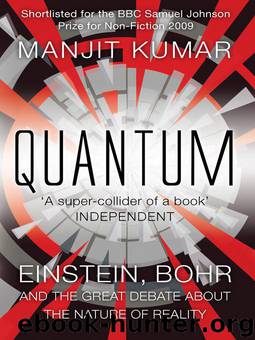Quantum: Einstein, Bohr, and the Great Debate About the Nature of Reality by Manjit Kumar

Author:Manjit Kumar [Kumar, Manjit]
Language: eng
Format: epub, mobi
Tags: Science, Physics, Biography, History
ISBN: 9780393078299
Publisher: W. W. Norton & Company
Published: 2008-01-01T15:00:00+00:00
Erwin with his psi can do
Calculations quite a few.
But one thing has not been seen:
Just what does psi really mean?42
Schrödinger finally proposed that the wave function of an electron, for example, was intimately connected to the cloud-like distribution of its electric charge as it travelled through space. In wave mechanics the wave function was not a quantity that could be directly measured because it was what mathematicians call a complex number. 4+3i is one example of such a number, and it consists of two parts: one ‘real’ and the other ‘imaginary’. 4 is an ordinary number and is the ‘real’ part of the complex number 4+3i. The ‘imaginary’ part, 3i, has no physical meaning because i is the square root of –1. The square root of a number is just another number that multiplied by itself will give the original number. The square root of 4 is 2 since 2×2 equals 4. There is no number that multiplied by itself equals –1. While 1×1=1, –1×–1 is also equal to 1, since by the laws of algebra, a minus times a minus generates a plus.
The wave function was unobservable; it was something intangible that could not be measured. However, the square of a complex number gives a real number that is associated with something that can actually be measured in the laboratory.43 The square of 4+3i is 25.44 Schrödinger believed that the square of the wave function of an electron, , was a measure of the smeared-out density of electric charge at location x at time t.
As part of his interpretation of the wave function, Schrödinger introduced the concept of a ‘wave packet’ to represent the electron as he challenged the very idea that particles existed. He argued that an electron only ‘appeared’ to be particle-like but was not actually a particle, despite the overwhelming experimental evidence in favour of it being so. Schrödinger believed that a particle-like electron was an illusion. In reality there were only waves. Any manifestation of a particle electron was due to a group of matter waves being superimposed into a wave packet. An electron in motion would then be nothing more than a wave packet that moved like a pulse sent, with a flick of the wrist, travelling down the length of a taut rope tied at one end and held at the other. A wave packet that gave the appearance of a particle required a collection of waves of different wavelengths that interfered with one another in such a way that they cancelled each other out beyond the wave packet.
If giving up particles and reducing everything to waves rid physics of discontinuity and quantum jumps, then for Schrödinger it was a price worth paying. However, his interpretation soon ran into difficulties as it failed to make physical sense. Firstly, the wave packet representation of the electron began to unravel when it was discovered that the constituent waves would spread out across space to such a degree that they would have to travel faster than
Download
Quantum: Einstein, Bohr, and the Great Debate About the Nature of Reality by Manjit Kumar.mobi
This site does not store any files on its server. We only index and link to content provided by other sites. Please contact the content providers to delete copyright contents if any and email us, we'll remove relevant links or contents immediately.
The Complete Stick Figure Physics Tutorials by Allen Sarah(7307)
Secrets of Antigravity Propulsion: Tesla, UFOs, and Classified Aerospace Technology by Ph.D. Paul A. Laviolette(5309)
Thing Explainer by Randall Munroe(3877)
The River of Consciousness by Oliver Sacks(3540)
The Order of Time by Carlo Rovelli(3145)
How To by Randall Munroe(3035)
A Brief History of Time by Stephen Hawking(2961)
I Live in the Future & Here's How It Works by Nick Bilton(2935)
The Great Unknown by Marcus du Sautoy(2648)
What If?: Serious Scientific Answers to Absurd Hypothetical Questions by Randall Munroe(2637)
Midnight in Chernobyl by Adam Higginbotham(2483)
Blockchain: Ultimate Step By Step Guide To Understanding Blockchain Technology, Bitcoin Creation, and the future of Money (Novice to Expert) by Keizer Söze(2446)
Networks: An Introduction by Newman Mark(2360)
The Meaning of it All by Richard Feynman(2300)
Easy Electronics by Charles Platt(2281)
The Tao of Physics by Fritjof Capra(2231)
Midnight in Chernobyl: The Untold Story of the World's Greatest Nuclear Disaster by Adam Higginbotham(2177)
When by Daniel H Pink(2083)
Introducing Relativity by Bruce Bassett(2080)
